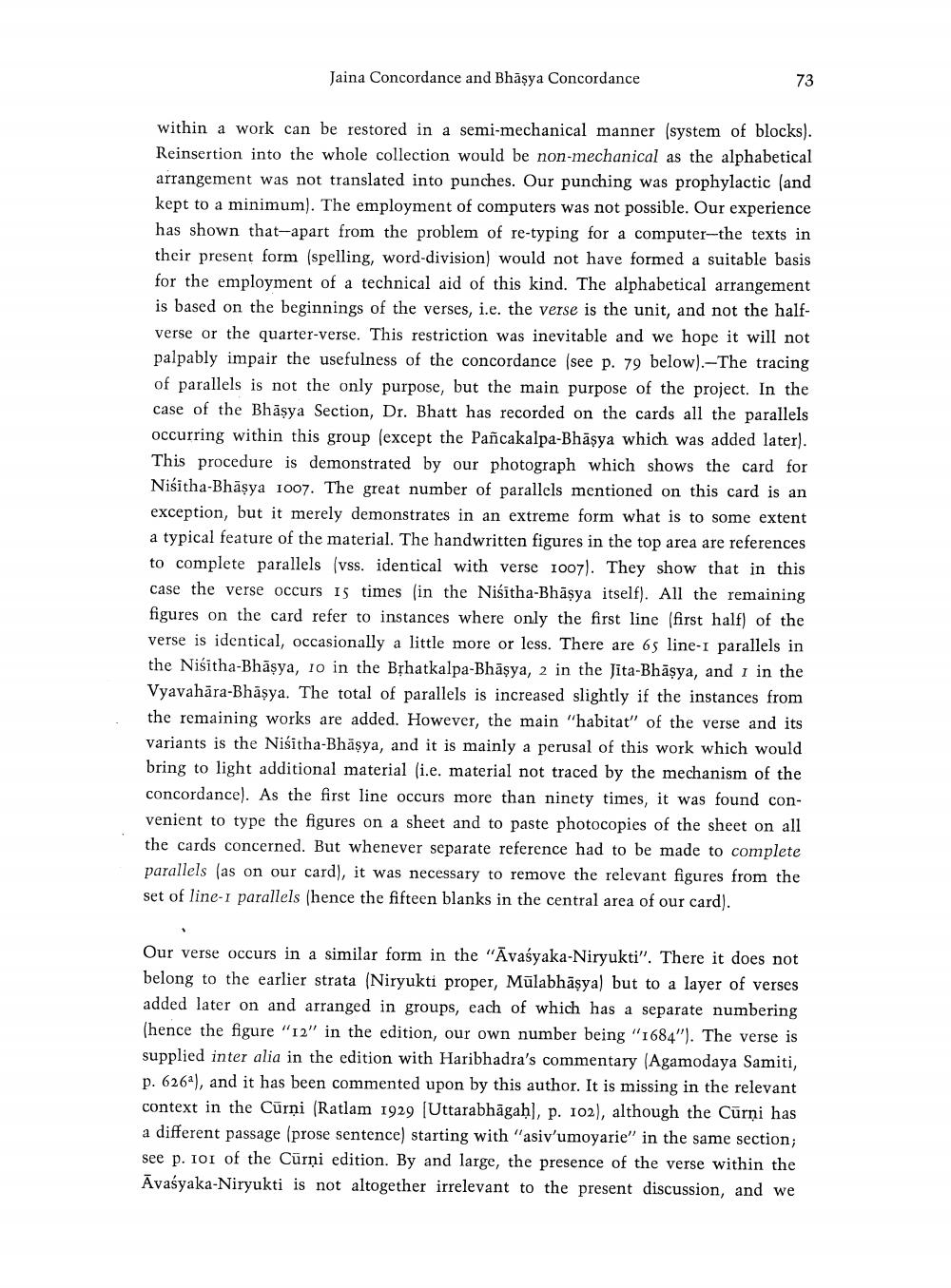________________
Jaina Concordance and Bhāşya Concordance
73
within a work can be restored in a semi-mechanical manner (system of blocks). Reinsertion into the whole collection would be non-mechanical as the alphabetical arrangement was not translated into punches. Our punching was prophylactic (and kept to a minimum). The employment of computers was not possible. Our experience has shown that-apart from the problem of re-typing for a computer-the texts in their present form (spelling, word-division) would not have formed a suitable basis for the employment of a technical aid of this kind. The alphabetical arrangement is based on the beginnings of the verses, i.e. the verse is the unit, and not the halfverse or the quarter-verse. This restriction was inevitable and we hope it will not palpably impair the usefulness of the concordance (see p. 79 below).- The tracing of parallels is not the only purpose, but the main purpose of the project. In the case of the Bhāşya Section, Dr. Bhatt has recorded on the cards all the parallels occurring within this group (except the Pancakalpa-Bhāşya which was added later). This procedure is demonstrated by our photograph which shows the card for Niśitha-Bhāșya 1007. The great number of parallels mentioned on this card is an exception, but it merely demonstrates in an extreme form what is to some extent a typical feature of the material. The handwritten figures in the top area are references to complete parallels (vss. identical with verse 1007). They show that in this case the verse occurs 15 times in the Niśītha-Bhāsya itself). All the remaining figures on the card refer to instances where only the first line (first half) of the verse is identical, occasionally a little more or less. There are 65 line-I parallels in the Niśitha-Bhāṣya, 10 in the BỊhatkalpa-Bhāşya, 2 in the Jita-Bhāșya, and 1 in the Vyavahāra-Bhāșya. The total of parallels is increased slightly if the instances from the remaining works are added. However, the main "habitat" of the verse and its variants is the Niśitha-Bhāşya, and it is mainly a perusal of this work which would bring to light additional material (i.e. material not traced by the mechanism of the concordance). As the first line occurs more than ninety times, it was found convenient to type the figures on a sheet and to paste photocopies of the sheet on all the cards concerned. But whenever separate reference had to be made to complete parallels (as on our card), it was necessary to remove the relevant figures from the set of line-1 parallels (hence the fifteen blanks in the central area of our card).
Our verse occurs in a similar form in the "Āvaśyaka-Niryukti”. There it does not belong to the earlier strata (Niryukti proper, Mūlabhāşya) but to a layer of verses added later on and arranged in groups, each of which has a separate numbering (hence the figure "12" in the edition, our own number being "1684"). The verse is supplied inter alia in the edition with Haribhadra's commentary (Agamodaya Samiti, p. 6262), and it has been commented upon by this author. It is missing in the relevant context in the Cūrņi (Ratlam 1929 (Uttarabhāgah), p. 102), although the Curņi has a different passage (prose sentence) starting with "asiv'umoyarie" in the same section; see p. 101 of the Cūrņi edition. By and large, the presence of the verse within the Āvasyaka-Niryukti is not altogether irrelevant to the present discussion, and we




